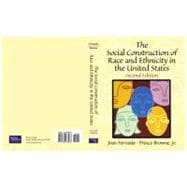
| Preface | xiii | ||||
| Introduction | 1 | (12) | |||
| PART 1 The Personal Experience of Classification Schemes | 13 | (100) | |||
|
29 | (4) | |||
|
|||||
|
33 | (6) | |||
|
|||||
|
39 | (4) | |||
|
|||||
|
43 | (7) | |||
|
|||||
|
50 | (2) | |||
|
|||||
|
52 | (3) | |||
|
|||||
|
55 | (8) | |||
|
|||||
|
63 | (5) | |||
|
|||||
|
68 | (2) | |||
|
|||||
|
70 | (3) | |||
|
|||||
|
73 | (8) | |||
|
|||||
|
81 | (4) | |||
|
|||||
|
85 | (5) | |||
|
|||||
|
90 | (8) | |||
|
|||||
|
98 | (7) | |||
|
|||||
|
105 | (8) | |||
|
|||||
| PART 2 Classifying People by Race | 113 | (102) | |||
|
129 | (15) | |||
|
|||||
|
|||||
|
135 | (3) | |||
|
|||||
|
138 | (6) | |||
|
144 | (7) | |||
|
|||||
|
151 | (13) | |||
|
|||||
|
164 | (2) | |||
|
|||||
|
166 | (2) | |||
|
|||||
|
168 | (4) | |||
|
|||||
|
|||||
|
172 | (4) | |||
|
|||||
|
176 | (22) | |||
|
|||||
|
198 | (6) | |||
|
|||||
|
204 | (11) | |||
|
|||||
|
|||||
|
214 | (1) | |||
| PART 3 Ethnic Classification | 215 | (74) | |||
|
|||||
|
230 | (4) | |||
|
234 | (4) | |||
|
|||||
|
238 | (3) | |||
|
|||||
|
241 | (5) | |||
|
|||||
|
246 | (3) | |||
|
|||||
|
249 | (8) | |||
|
|||||
|
257 | (7) | |||
|
|||||
|
264 | (10) | |||
|
|||||
|
274 | (15) | |||
|
|||||
| PART 4 The Persistence, Functions, and Consequences of Social Classification | 289 | (70) | |||
|
305 | (5) | |||
|
|||||
|
|||||
|
308 | (2) | |||
|
310 | (6) | |||
|
|||||
|
316 | (7) | |||
|
|||||
|
323 | (9) | |||
|
|||||
|
332 | (5) | |||
|
|||||
|
337 | (14) | |||
|
|||||
|
|||||
|
|||||
|
340 | (11) | |||
|
351 | (8) | |||
|
|||||
|
|||||
|
355 | (4) | |||
| PART 5 Toward a New Paradigm: Transcending Categories | 359 | (126) | |||
|
376 | (10) | |||
|
|||||
|
386 | (2) | |||
|
|||||
|
388 | (12) | |||
|
|||||
|
400 | (9) | |||
|
|||||
|
409 | (18) | |||
|
|||||
|
|||||
|
|||||
|
415 | (12) | |||
|
427 | (2) | |||
|
|||||
|
429 | (6) | |||
|
|||||
|
435 | (2) | |||
|
|||||
|
437 | (14) | |||
|
|||||
|
|||||
|
441 | (10) | |||
|
451 | (8) | |||
|
|||||
|
|||||
|
459 | (14) | |||
|
|||||
|
473 | (6) | |||
|
|||||
|
479 | (3) | |||
|
|||||
|
482 | (3) | |||
|
|||||
| Appendix A Race---The U.S. Bureau of the Census (1996) | 485 | (8) | |||
| Appendix B Federal and Program Uses of the Data Derived from Race and Ethnicity Questions---The U.S. Bureau of the Census (1990) | 493 | (6) | |||
| Appendix C Answers to Table 5.2: Who Gets Caught? | 499 | (4) | |||
| References | 503 | (8) | |||
| Text Credits | 511 | (6) | |||
| Photo Credits | 517 | (2) | |||
| Index | 519 |
The New copy of this book will include any supplemental materials advertised. Please check the title of the book to determine if it should include any access cards, study guides, lab manuals, CDs, etc.
The Used, Rental and eBook copies of this book are not guaranteed to include any supplemental materials. Typically, only the book itself is included. This is true even if the title states it includes any access cards, study guides, lab manuals, CDs, etc.